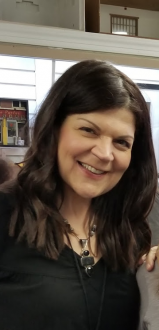Those in the know flock to college campuses for intellectually stimulating and affordable events with significant content and entertainment value.
On my return to the campus of Fairfield University for my second visit in a month’s time, I was impressed to witness the scope of programming offered, not only to engage the college’s own constituents, but the community at large.
The Fairfield University Art Museum (FUAM), composed of the jewel-like Bellarmine Hall and modern Walsh Gallery, provides a vehicle for the presentation of its impressive permanent collection as well as robust rotating exhibits that resonate with a broad and diverse audience.
Established in 2010 as Bellarmine Museum of Art and originally funded with a National Endowment for Humanities grant, FUAM houses its own array of international artworks and antiquities. It also features original objects on loan from the collections of The Metropolitan Museum of Art, Penn Museum, Columbia and Princeton universities, Worcester Art Museum and the American Numismatic Society, says Carey Mack Weber, FUAM’s assistant director.
On view in the Bellarmine Hall Galleries are paintings by European and American masters and interesting groupings of Asian, African and pre-Columbian objects, including a lovely assortment of ancient coins. Of particular note are figures from China’s Tang Dynasty (circa 600-900) and Song Dynasty (10th through 13th centuries), considered by many art historians as a particularly prolific cultural period for China. All its permanent works and those on-loan are nicely catalogued on the museum’s website.
To commemorate the university’s 75th anniversary earlier this year, FUAM hosted a highly touted exhibit of artworks from the Roman Church of the Gesù, including several never before seen in the United States. A nod to the institution’s Jesuit heritage, the landmark exhibit featured Gian Lorenzo Bernini’s bust of Roberto Bellarmino, the institution’s patron saint, and more than 50 original treasures by Italian Baroque masters.
In addition to curating thoughtful exhibits, the museum serves the Fairfield community and beyond by offering admission to exhibits and attend other public events mostly free of charge. Students in the greater Bridgeport area are offered access, too, via complimentary half-day programs for grades K-12, including gallery activities, hands-on art workshops, lunch and transportation.
Michelle DiMarzo, the museum’s curator of education and academic engagement, is herself a Fairfield University graduate who went on to obtain her doctorate in art history from Temple University. “We have ongoing partnerships with the Barnum School (fifth grade of a Turnaround Arts school for the underserved), Adam J. Lewis Academy (a pre-kindergarten) and the Classical Studies Magnet Academy, among others,” she told me.
Through the exhibits and programs, and with the support of community partners and alumni, FUAM is able to sustain its vibrant programming and foster its commitment to the arts. The museum engages in many cross promotions with partners in Fairfield County and participates in the Connecticut Art Trail, a unique alliance of 21 museums and historic sites across the state, of which Mack Weber serves as president. She told me that the organization sells an “Art Passport” at an attractive price, offering admittance and discounts for one-time use at each location over the course of a year.
Many programs at FUAM this fall — including “Collateral Damage,” an exhibit of work by Mohamad Hafez that’s on view through Dec. 15 in the Walsh Gallery at the Quick Center for the Arts — are doing much to heighten awareness of international refugees. Fitting, then, that this Syrian-born artist and U.S.-raised and educated architect, creates assemblages working with miniature-scaled, found objects to depict scenes of both construction and destruction in his native Damascus. Rounding out this exhibit are select works by two other contemporary Syrian artists — Hala el-Abed, a photographer and digital artist, and Waref Abu Quba, a filmmaker — which touch on themes of violence and loss surrounding the Syrian refugee crisis.
During the opening reception and talk, Hafez, whose studio is in New Haven, spoke of the cathartic process of creating his works — initially, as a way to bring to life architectural streetscapes — and then to demonstrate the havoc resulting from the Syrian Civil War, starting back in 2011. He experienced this tumult through accounts of family members and others who fled by sea after the outbreak, hastily leaving the destruction.
Represented in the current exhibition in Fairfield are the tableaux of Syrian buildings whose facades appear to have been stripped away, revealing scenes of a chaos left behind. Also featured are pieces from his “Baggage” series — refugee “stories” mounted in worn, vintage suitcases, some with audio, delivering sound bites of interviews with refugees from all over the world who have settled in the New Haven area. As Hafez describes it, his body of work has an educational component providing an opportunity for him to tell the story that the press does not and to humanize the large population of refugees.
Hafez creates his art with a passion that arose out of a strong sense of responsibility — one that sits directly upon his shoulders, he told the audience. This theme of responsibility surfaced more than once during his talk — the compulsion to
acculturate these moving accounts through art is what drives and motivates him as an artist. Hafez believes that embracing diversity and fostering civil conversations can bring people together rather than pulling them apart. At the end of the day, he told us, “what draws us together, as a people, is much bigger than what divides us.”
For more, visit fairfield.edu/museum/ and ctarttrail.org.







I visited the Bellarmine twice because they received works of art from the Samuel H. Kress Foundation in 1961, during what Life Magazine called “The Great Kress Giveaway.” You are cordially invited! Samuel H. Kress and his brother Rush H. Kress, amassed one of the largest and prestigious collections of mostly Italian Renaissance and Baroque art in the world, and donated half of the 3,107 paintings, sculpture, medals and decorative art to over 90 US institutions, and over half going to the National Gallery of Art in Washington DC. Join Steve on the journey of the Kress Family Legacy, going back to 800 AD to the present day, exploring the Samuel H. Kress Foundation, Rush H. Kress’ 72-acre Rock Hill Estate in Ossining NY and the seeding of many museums around the country. Mr. Worthy is the go-to guy for the Kress Foundation when fielding public inquiries about the Kress family. His illustrated lecture will take place Dec. 2nd at 2:00 pm at the Ossining Arts Council Steamer Gallery at 117 Main St. in Downtown Ossining. The exhibition of some 60 photographs, maps and other visuals from his private collection, as well as received from Kress relatives and other sources, will be displayed for the entire month of December. Contact Mr. Worthy at 914-494-8127 or worthysteven@gmail.com.